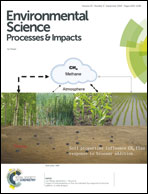Assisted natural recovery of hypersaline sediments: salinity thresholds for the establishment of a community of bioturbating organisms†
Abstract
Hypersaline sediments derived from poor land management or the decommissioning of large-scale salt production contribute to the long-term degradation of aquatic environments. Obstacles impeding remediation of these environments include salt crusts restricting benthic recolonisation, hypersalinity-induced toxicity to organisms, and disruption of biogeochemical cycles. Remediation often focuses on engineered solutions, despite sediment–biota interactions often playing a crucial role in improving long-term remediation and restoration of contaminated areas. The presence of extensive bioturbating communities can assist with flushing of excess salt ions, and the reduction of excess nutrients. Here we investigated the tolerance limits that may impede benthic organism recolonisation of hypersaline sediments. Bioassays on dilutions of a hypersaline sediment (∼400 psu (practical salinity units)) and extracted porewaters were used to assess the acute and chronic tolerances of a range of benthic species. Amphipod, copepod and shrimp species were the least tolerant to hypersalinity; bivalve and gastropod species displayed intermediate tolerance; and crab and polychaete species were the most tolerant, i.e. able to endure prolonged exposure in waters at ≥60 psu. Avoidance tests found many species avoid salinities >50 psu. Short-term endurance tests (time to death) indicated thresholds in the 52–70 psu range through tidal cycle exposures of 6 h (semi-diurnal), 12 h (diurnal), 24 h and 48 h (prolonged). Amphipod reproduction and shrimp larvae development bioassays had EC30's of 46 psu and EC50's in the 54–65 psu range, indicating potential to maintain populations at salinities up to 65 psu. These results will assist in designing successful monitored natural recovery strategies for salt ponds that may supplement the initial engineered approaches.



 Please wait while we load your content...
Please wait while we load your content...